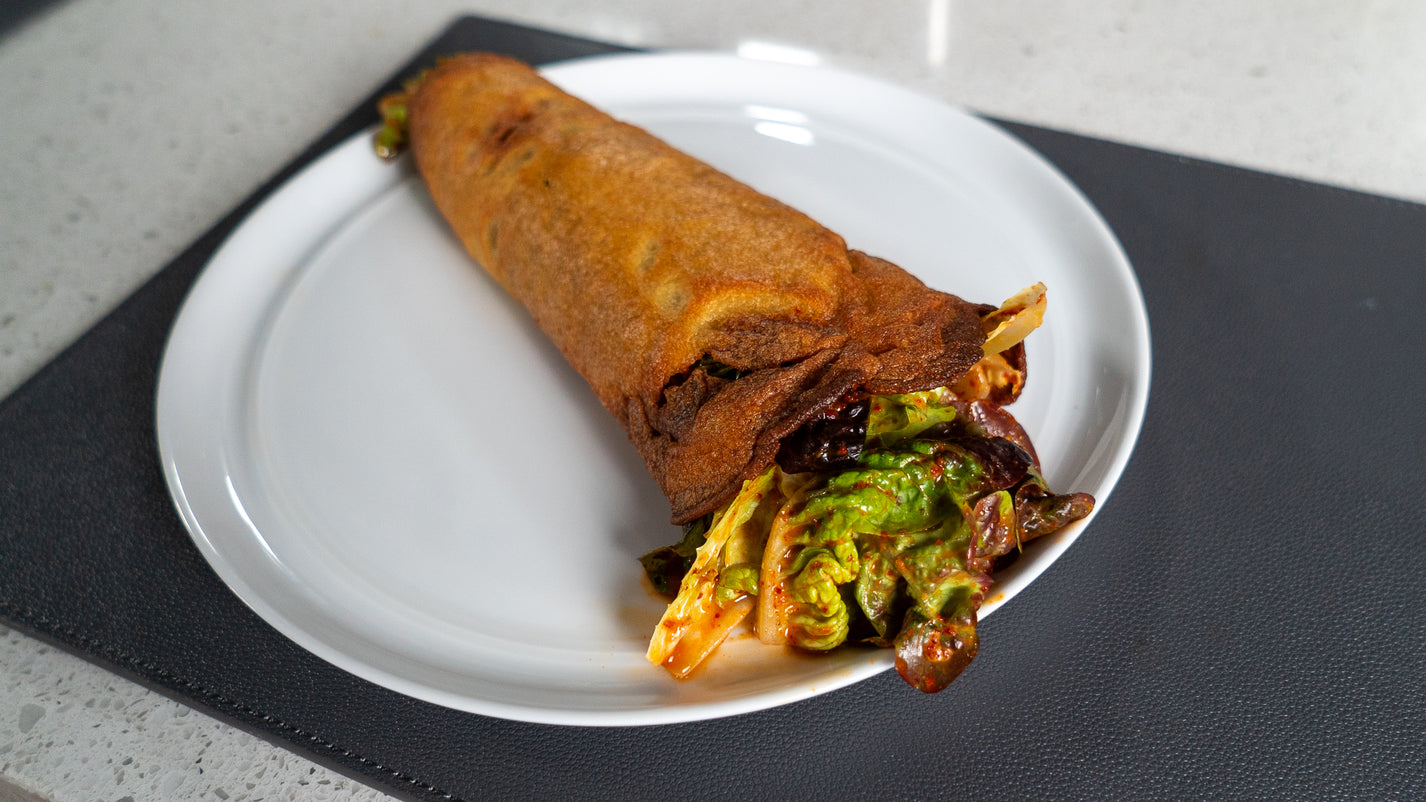Recipe by David Chang
"These are not really bindaetteok. They’re not dosas. They’re not crepes, either. They’re somewhere in the middle of all that. There are probably some people who will be driven crazy by this, but it’s what I love about food. The more you look around, the more you realize that everybody wants to eat the same thing. A thin, savory pancake — crispy or not — wrapped around delicious fillings. That’s universal. What we served on the show tonight started as bindaetteok — a Korean mung bean pancake typically filled with pork, beansprouts, and kimchi — but I wanted to make something crispy, with more structure, like a South Indian dosa. I filled it with Korean flavors and some of the ingredients you’d see in a bindaetteok, but I made it more of a salad for my vegan friends.I’m really happy with how the cone turned out. It’s savory and crunchy. Wrapping it as a cone is a pain in the ass, though, so if you make it at home, I wouldn’t necessarily bother. Also, if you’re not vegan, you can fill or top these with whatever meaty treats you like."
Crispy Bindaetteok Cone
- 1 1/2 cups dried, shelled mung beans
- 1/4 cups short grain rice
- 1/2 cup mochiko flour
- 2 cups mixed lettuces
- 6 scallions, greens only, sliced thin
- 2–3 ripe tomatoes, quartered
- Salt
- MSG
- Olive oil
- Small Silpats (silicone baking mats)
Vinaigrette
- 5 cloves garlic, minced
- 1-inch piece ginger
- 2 tablespoon sugar
- 2 tablespoon soy sauce
- 1/4 cup rice wine vinegar
- 2 tablespoon kochukaru (Korean chili flake)
- 2 tablespoon toasted sesame seeds
- 1 teaspoon sesame oil
Place the mung beans in a bowl and cover with a couple inches of water. Cover and let soak overnight. In a separate bowl, soak the short grain rice in water as well.
The mung beans should have doubled in size overnight. Strain the mung beans and rice, and add to a blender, along with the 2 cups of water Add the mochiko, along with 2 tablespoons of olive oil, then blend until you have a smooth, crepe-batter consistency. If it looks a little too thick, add more water. Season with salt and a pinch of MSG.
Preheat the oven to 350 degrees Fahrenheit.
Heat a nonstick skillet over medium heat, then coat with a layer of crepe batter. You don’t want it quite as thin as a French crepe, but definitely not as thick as an American pancake. Once the crepe is set, lift up the edges with a spatula and add a little oil to the pan to help crisp things up.
Cook the pancake on one side until mostly cooked through, then flip and finish on the other. Once the pancake is browned on both sides, transfer to a cutting board. If you like, you can roll a small Silpat into a cone, and drape the pancake around it. Otherwise, just lay it flat on a sheet pan. Repeat with the remaining batter, then slide the sheet pan into the oven for 25 minutes or until the pancakes are browned and crispy-crunchy. Let cool before filling.
Make the vinaigrette by blending together all the ingredients with a splash of water. Check for seasoning, then dress your salad greens, scallions, and tomatoes. Stuff into the bindaetteok cone and top with any leftover dressing. Serve.
Watch Dinner Time Live with David Chang on Netflix now, and tune in every Tuesday at 4 p.m. PST to watch live.

